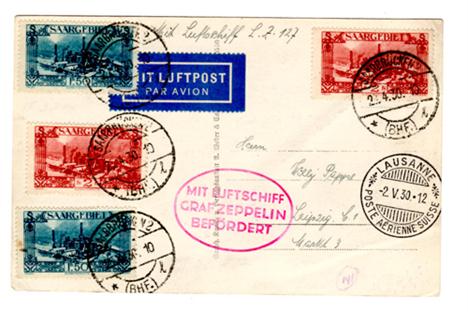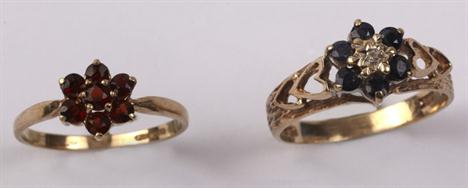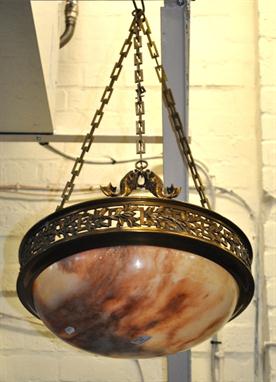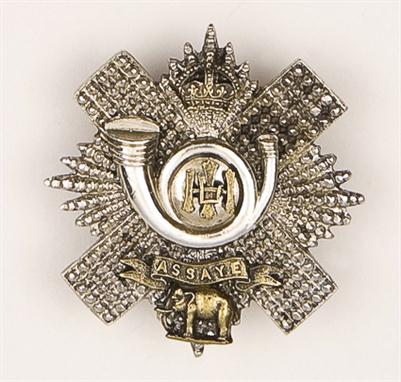A very early tinplate airship toy. Of French origin based on the original basic designs of the early 1900’s. 26.5cm. In sandy light brown with ‘Liberte’ to one side, open gondola with flat figure holding a telescope. Simple clockwork motor to rear, with basic replacement propeller. GC for age some paint missing. See Plate.2
534325 Preisdatenbank Los(e) gefunden, die Ihrer Suche entsprechen
534325 Lose gefunden, die zu Ihrer Suche passen. Abonnieren Sie die Preisdatenbank, um sofortigen Zugriff auf alle Dienstleistungen der Preisdatenbank zu haben.
Preisdatenbank abonnieren- Liste
- Galerie
-
534325 Los(e)/Seite
A copy of a Tipp & Co tinplate clockwork lithographed airship toy ‘Graf Zeppelin D-LZ 127’. 27cm. In gold tinted silver finish with ‘Graf Zeppelin’ and ‘LZ 127’ to canopy sides, large silver finish two bladed propeller to rear, hanging loop to top. Clockwork action with fixed winding key, in working order. GC some production creases and light wear overall. See website.
A Tipp & Co tinplate clockwork lithographed airship toy ‘Graf Zeppelin D-LZ 127’. 34cm. In gold tinted silver finish with black line detailing, ‘Graf Zeppelin’ and ‘D-LZ127’ to sides, large yellow, two bladed propeller to rear, hanging loop to top. Clockwork action with fixed winding key, not in working order. GC-VGC some light rusting and wear. See Plate.2
A Tipp & Co tinplate clockwork lithographed airship toy ‘Graf Zeppelin 2 DLZ 130’. 34cm. In gold tinted silver finish with dark blue line detailing, ‘Graf Zeppelin’ and ‘D-LZ130’ to sides, large red, (now faded to orange) two bladed propeller to rear, hanging loop to top. Clockwork action with fixed winding key in working order. GC some light rusting and wear. See Plate.3
A Tipp & Co tinplate clockwork lithographed airship toy ‘Graf Zeppelin DLZ 127’. 63cm. In gold tinted silver finish with dark blue line detailing, ‘Graf Zeppelin’ and ‘DLZ127’ to sides, large yellow two bladed propeller to rear, two hanging loops to top, four engine pods with propellers, battery powered light within the control cabin. Clockwork action in working order but key missing. Boxed, some age wear. Zeppelin VGC minor wear only. See Plate.3
A Tipp & Co tinplate clockwork airship toy ‘Hindenburg DLZ 129’. 28cm. Painted in silver with lithographed blue line detailing, cabin windows and German Third Reich emblem on tail fins, two hanging loops to top, with original two bladed celluloid propeller, with stop/start lever. GC some light wear overall. clockwork motor AF. See Plate.3
A Marklin tinplate clockwork ‘Graf Zeppelin’ toy. 41cm. Painted in silver, ‘Graf Zeppelin’ in red and ‘D-LZ 127’ in black to one side only. 5 engine pods and control cabin to the front. Clockwork motor in working order. Fitted with a large alloy propeller. Basically QGC-GC some age wear/light rusting overall. Propeller bent. See Plate.3
A Lehmann tinplate clockwork airship toy. 19cm. In anodised light gold finish with red and black llithographed detailing, named ‘Shenandoah’ with the U.S. star markings. Also marked ‘766 Marke, Lehmann’ and patent information. Fitted with two open gondolas, two rear fins and single stylised propeller and single hanging loop to top. GC for age and type. Some wear overall and denting. Clockwork motor in W.O. See Plate.3
A Lehmann tinplate clockwork airship toy. 19cm. In anodised light gold finish with black litho detailing, named ‘EPL.1’. Also marked ‘651 Marke Lehmann’ and patent information. Fitted with two open gondolas, two rear fins and single rear propeller, single hanging loop to top. QGC. Worn overall. See website.
A Lehmann tinplate clockwork airship toy. 19cm. In anodised light gold finish with red and black litho detailing, named ‘EPL.1’. Also marked ‘651 Marke Lehmann’ and patent information. Fitted with two open gondolas, two rear fins and single rear propeller, single hanging loop to top. GC-VGC for age. See Plate.3
A Japanese produced tinplate clockwork lithographed airship toy. 16cm. In the style of a British airship, in light blue and light grey striped livery, with RFC/RAF roundels and markings numbered R.107 with the registration G-FAAW all in red. Fitted with a celluloid propeller, with a hanging loop to the top. With a fixed key, clockwork action in working order. See website.
An early, probably pre WW2 Japanese, (produced by K.K.) clockwork ‘Air Ship’ toy. 18cm. In light weight alloy with an un-painted finish, two simple open gondolas underneath, single propeller with clear celluloid blades, fixed key to working clockwork motor. Hanging loop to top with cord. Boxed with instructions. Toy, VGC minor wear only. See Plate.4
A North American produced by MARX tinplate clockwork airship toy. 27cm. In silver painted tinplate, with red compartment and blue engine pods. Central large powered propeller, with fixed key to rear, clockwork motor in W.O. Boxed, worn/damaged. One engine pod loose. Zeppelin. GC some light rusting. See Plate.4
A 1930’s style Chair-O-Plane tinplate toy. 21.5cm high. This American produced ‘AERO-ZEP’ toy comprises 3 airships/Zeppelins in white with red stripes and pink coloured propellers, suspended from a canopy supported by a thick tinplate central pillar. To the top canopy are printed pictures of a 1930’s style radial engined monoplane with city names (destinations?) to the canopy edge- Berlin, New York, Buenos Aires, London, Paris, Jerusalem. The lower canopy is decorated with nine boys and girls holding hands around the central pillar. The main structure is lime green, with pink and red detailing. Has a Bison trade mark to top of canopy. GC. Some light wear overall. Action A.F. See Plate.7
A silver plated cocktail shaker in the form of a Zeppelin. In 3 sections, the nose cone ice compartment, centre section with strainer, tail section reservoir. The tailfins allow the item to be placed in an upright position. Also fitted with dummy wheels and cupola. 32cm in length. VGC light cleaning is required. See Plate. See website
A German patent silver plated cocktail shaker and serving set for four persons, all in the form of a Zeppelin. In 3 sections which unscrew to reveal a flask with nozzle and screw cap. 3 nests of 4 gilt lined cups (1 cup missing), one nest including small toastmaster’s goblet with detachable stem concealing a corkscrew, lemon squeezer and strainer marked ‘DRGM 384384. Made In Germany’. Detachable gondola containing 4 small spoons. Fitted with tailfins allow the item to be placed in an upright position. Engraved with two initials. ‘RV’ 30cm in length. VGC light cleaning is required. See Plate.13
A rare electric hand turned card flicker machine. A heavy cast iron arcade style machine made by the ‘American Mutoscope and Biograph Company.’ This example is painted in cream with Indian Chief and eagle decoration. A bison is the decoration to the back of the picture plate at the top of the machine. This holds an example of what can be seen within. As this machine, which unfortunately is inoperable, is part of an airship collection with 2 discs showing the Hindenburg crash. Generally in good condition but does have some age wear. Action requires attention. See inside front cover. Note: The Mutoscope worked on the same principle as the “flip book.” The individual image frames were conventional black and white silver based photographic prints on tough, flexible opaque cards. Rather than being bound into a booklet, the cards were attached to a circular core, rather like a huge Rolodex. A reel typically held about 850 cards, giving a viewing time of about a minute. The reel with cards attached had a total diameter of about ten inches (25 cm); the individual cards had dimensions of about (7 cm x 4.75 cm). Mutoscopes were coin-operated. The patron viewed the cards through a single lens enclosed by a hood. The cards were generally lit electrically, but the reel was driven by means of a geared-down hand crank. Each machine held only a single reel and was dedicated to the presentation of a single short subject, described by a poster affixed to the machine. The patron could control the presentation speed only to a limited degree. The crank could be turned in both directions, but this did not reverse the playing of the reel. Nor could the patron extend viewing time by stopping the crank because the flexible images were bent into the proper viewing position by tension applied from forward cranking. Stopping the crank reduced the forward tension on the reels causing the reel to go backwards and the picture to move from the viewing position; a spring in the mechanism turned off the light and in some models brought down a shutter which completely blocked out the picture.
Zeppelin Menu. ‘Graf Zeppelin’ 1928 menu card. Dated 11th October 1928 and signed by Albert Lehman ‘From the crew of Graf Zeppelin’. Together with a 1929 menu card from the second flight from Lakehurst to Friedrichshafen. Complete with a Bord Cachet in violet. Rare. GC, some light wear. See Plate.15
Poster Stamps–Pre WW1. Reichsverein Fur Luftschiffahrt. (National Airship light Fund). 6 Imperf. blocks of 6, same design in different colours. Each shows a standing figure looking at a Zeppelin, a balloon and an early aircraft. Together with (2) Invention & Patent Exhibition in Brno 1913: 22 labels in different colours, showing a reclining man with Zeppelin above. Dated 7-21 IX 1913. A good lot. GC, minor marks to a few. See website.
Zeppelin Memorabilia. DZR advertisement card. A poster, 21cm x 30cm, advertising ‘2 days across the Atlantic’ with a coloured view of Zeppelin ‘Hindenburg’ over the ocean. Stiffened and with a bracket to display on a travel agent’s counter. Together with a Hamburg-America Line advertisement depicting a Zeppelin over a busy dock scene. 23cm x 20cm. Both interesting items. GC, some light wear. See Plate.25
A 12 BORE HAMMER ACTION SIDE-BY-SIDE DOUBLE BARRELLED SHOTGUN number 1849, with checkered stock, hammer action and engraved under lever, the barrels marked Eprouve Aux Poudres Pyroxylees. 110cm(overall) *** a current shotgun licence is required to purchase this lot and must be produced on payment, bidding on behalf of a third party is forbidden. Condition Report: Used condition with some pitting and light corrosion, viewing advised.
A LARGE CRAFTSMAN MADE LIGHT OAK CORNER BOOKCASE of L-shaped construction, having a slender moulded cornice above a central glazed cupboard door flanked by narrow open shelves sections and further glazed cupboard doors, the lower stage having five fielded panelled doors enclosing further adjustable shelving, raised on bracket feet. 222cm(h) x 239cm(w) x 68cm(d) Condition Report: Very minor defects otherwise good condition.
Jack B. Yeats RHA 1871-1957 THE NIGHT HAS GONE (1947) Oil on canvas, 18" x 24" (46cm x 61cm), signed. Exhibited: 1947 Dublin (9); 1948 Leeds: 1948 London (78) Provenance: Sold at the exhibition in 1947 to Miss H. MacMahon, later Mrs. Gertrude Feuerring, New York. `The artist walks alone in the landscape , his head surrounded by the night sky above the low horizon. But the night is rolling away, and light is breaking out in the east`- Jack B. Yeats, A Catalogue Raisonne of the Oil Paintings by Hilary Pyle, No 876, page 791, Vol II
Jack B. Yeats RHA, 1871-1957 FRESH HORSES (c.1914) Oil on board, 14" x 9" (35.5 x 23cm), signed Exhibited: 1914 London (25); 1917 London Allied Artists; 1918 Dublin (13); 1965 London (1) Provenance: Sold by the artist to L. Smith, 1946, later R MacGonigal, Dublin. Later sold by Victor Waddinon, London, 1965. Also Peter O`Toole, London and Waddington Galleries, London. Literature: `Jack B. Yeats, A Catalogue Raisonneof the Oil Paintings` by Hilary Pyle, No 91, page 78, Vol I, where she writes: `An ostler holding the heads of two skittish horses in the darkness. His scarf and the harness catch the light. This oil was developed from a sketch in one of Yeat`s Belmullet notebooks (sketchbook 101; Sligo Museum), which has the inscription ` Changing horses on the way to Belmullet`. Yeats and Synge travelled by mail car- a long car- to Belmullet in July 1905. The painting may be earlier than 1914, with its firmly worked single figure and night lighting being closer to compositions of 1911- 12 (27, 39). The trip with Synge imprinted itself firmly on Yeat`s memory, and he recalled incidents from it at intervals`- Jack B. Yeats, A Catalogue Raisonneof the Oil Paintings by Hilary Pyle, No 91, page 78, Vol I.
Jack Butler Yeats RHA (1871-1957) AGAINST THE STREAM, 1945 oil on board signed lower left; inscribed with title on reverse; also with inscribed Dawson Gallery label on reverse and typed Waddington Galleries, London label on reverse 9 by 14in., 22.86 by 35.56cm. Dawson Gallery, Dublin; Where purchased by a Mr F.S. Hess; with Waddington Galleries, London; Where purchased by a Mr Daniel O`Keeffe; Private collection A man walks briskly along a river bank pulling a small barge in the water along behind him. The dramatic contrast in scale between him and his passengers suggest that the latter is a toy or that some fantastic scene is before us. Yeats` intricate handling of the paint conveys a breezy day with the trees on the bank blowing in the gentle wind. The bright blues of the sea and river compliment the dark greens and yellow tones of the surrounding vegetation and suggest the warmth of a summer`s day. The blue paint of the water has been scraped back in parts to reveal the white of the board underneath. This denotes the reflected light of the sky on the surface of the river, while drawing our attention to the physical construction of the painting. The pink shirt and grey trousers of the ferryman while contrasting in hue with that of its environs are blended into the composition through the way in which the artist has sculpted the form out of paint. Rivers and ferrymen are a major theme in Yeats` work. The ferryman, like the pilot man who guided the ships in and out of port, is symbolic of an innate wisdom and a keen understanding of the complexities of the sea and the tide. The title of this work Against the Stream indicates the skill of the man as he manoeuvres the boat upstream. Rivers are moving forces and as such they represent the unending progress of life and nature. The sense of journeying is keenly expressed in this work through the movement of trees, the water and above all by the striding figure and the boat. The wide spread of the composition takes in the breadth of the river and its opposing bank and thus sets the expedition of the man and the boat within the much greater context of natural forces. In a playful manner Yeats uses the work to pose quite profound questions about the purpose of an individual life set against the bigger forces of the natural world. Dr. Róisín Kennnedy November 2012 "
A Geo V RN officer’s sword, almost straight, fullered blade 31½”, by Stumbles & Son, 43 Fore Street, Devonport, etched with crowned fouled anchor and crowned GVR cypher, within scrolls, in frosted panels, regulation copper hilt incorporating crowned fouled anchor and hilt turn down inner portion which locks to scabbard, lion’s head pommel and backstrap, with dress knot, in its brown mounted leather scabbard. GC, the blade retaining much original polish (one or two light pitting patches) Plate 6
A 1912 pattern cavalry officer’s sword, blade 35”, etched with crowned GVR cypher in scrolled panels, regulation plated bowl guard engraved with scroll pattern overall, ornamental pommel, wirebound shaped sharkskin grip, with brown leather knot, in its plated scabbard with opposing rings. GC (blade light surface pitting) Plate 6
-
534325 Los(e)/Seite




















































